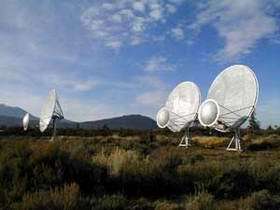Scientists: 'We'll detect an extraterrestrial transmission within 20 years'

The SETI Institute predicts that we'll detect an extraterrestrial transmission within twenty years. If that turns out to be true, it'll probably be the folks at UC Berkeley's Hat Creek radio observatory who will have heard the call. Right now, the Allen Telescope Array of more than three-hundred dishes is under construction at Hat Creek five hours north of San Francisco. Within a year, the first thirty dishes will be operational, forming the basis of a giant ear that listens for intelligent beings in space while simultaneously gathering data for groundbreaking astronomy research.
Image: Three prototype radio dishes now in place at Hat Creek Observatory in northern California. By 2007, 350 of these 6.1-meter-diameter dishes will be assembled to form the Allen Telescope Array, the largest radio array in the world. (courtesy Radio Astronomy Laboratory)
William "Jack" Welch, UC Berkeley professor of electrical engineering and astronomy, has been a driving force in the design and construction of the Allen Telescope Array (ATA) since the project first got off the ground five years ago as a joint effort between UC Berkeley and the SETI Institute. Named for major donor Paul Allen, co-founder of Microsoft, the array will eventually consist of 350 6.1-meter radio dishes electronically networked together into a radio telescope with unprecedented sensitivity. Precisely distributed across 2.6-acres on the Hat Creek grounds, the combined dishes will have far greater sensitivity than much more expensive 100-meter telescopes.
The SETI project scours millions of radio channels for narrow-band signals, indicative of intelligent origin. It's like listening for a station as you twist your car radio's tuning knob past all the static. Until now, SETI has used limited time from myriad radio telescopes around the world, limiting the number of stars that can be observed. However, the ATA will be dedicated to the project, speeding up the SETI search by a factor of 100. Meanwhile, the unique design of the system enables astronomers to monitor a huge range of wavelengths to observe other cosmic phenomena simultaneously with the SETI search.
"SETI is admittedly a long-shot," says Welch, holder of UC Berkeley's first Chair in the Search for Extraterrestrial Intelligence. "I don't have the patience to do only that, so it appeals to me to have a steady flow of other data for us to study as well."
For example, Welch and his colleagues will use the array to make a cosmological map of atomic hydrogen, the most abundant element we know of. Indeed, the visible universe may be composed of up to ninety-percent hydrogen. Determining its spatial distribution in nearby galaxies could provide insight into the evolution of the cosmos and the mysteries of dark matter.
"We'll be able to look halfway back to the beginning of the universe," Welch says. "The ability to observe that far back into time is limited right now."
To crank up the telescope's sensitivity, Welch and his colleagues devised a bit of ingenious antenna technology. In traditional pyramid-shaped antennas like those used in the ATA, the signal is picked up at the tip of the structure, called the feed, and runs down wires to the receiver. The problem, Welch explains, is that much of the signal gets lost along the way. To keep the signal as pure as possible, the Berkeley researchers shoehorned the receiver components inside the feed itself.
"It's just one new wrinkle for technology that was originally developed in the 1950s, but it enables our feed to essentially have no limitation on bandwidth," Welch says.
Right now, just three prototype dishes are being put through their paces at Hat Creek. In the next few months though, the researchers will install more than two-dozen others, nearly one dish a day. By Summer, Welch hopes this first small array will be scanning stars many light-years away. Whether ET is intelligent enough to call remains to be seen, or rather heard, but Welch is convinced that there's something out there.
"The recent discovery of planets around many nearby stars is a strong argument that our solar system isn't really unique at all," he says. "That in itself makes it almost certain that there are nearby planets with some kind of life on it."
Source: UC Berkeley (by David Pescovitz)

















